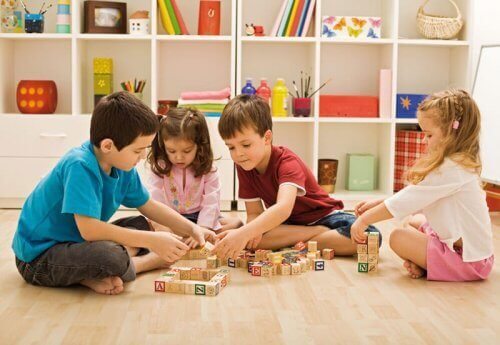Games for Children between the Ages of 3 and 5

During this time in your child’s life, as in the previous stage and those to come, play is an exercise that can offer your little one many advantages.
Below, we’ll explain some fun activities to help your child to mature and develop.
The best games for children between the ages of 3 and 5
1. Hide and Seek
Almost all children enjoy this game. At this age, children are just starting to develop their sense of space. This makes searching high and low for someone a great and exciting challenge.
This game requires no props or special equipment. It also encourages socialization, as it involves two or more people.
Lastly, the activity requires your child to make decisions – where to hide and where to seek. This also develops their ability to create strategies.
The rules are the following:
- One of the participants counts to 10 (or whatever number you agree upon) while the rest of the participants hide within the pre-established boundaries.
- After counting, the seeker searches for the rest of the players.
- When the seeker finds another player, he can tag him to eliminate him. Another variation of this activity is for the two to race back to the counting spot. The last to arrive is out, or becomes the next seeker, depending on the established rules.
2. Simon Says
Like so many other games for 3, 4 and 5-year-olds, this activity focuses on following the rules and interpreting the requests and demands of others.
In a way, this is a great preparation for your child’s preschool years. It’s also a game that stimulates language, another ability that your child is still developing.
This game involves 3 or more players. One player is “Simon” and should give simple orders to the other two players (such as “jump up and down” or “raise your hand”).
However, the other players should only obey if Simon precedes the command with “Simon says.”
When a player obeys an order that wasn’t preceded by “Simon says”, the player is eliminated from the game. The same is true if a player does not obey an order that does come with the phrase “Simon says.”
If a player obeys an order incorrectly, this also calls for elimination. The last player in the game wins, and can be the next Simon

3. Role playing
Dressing up and role playing are very effective ways to stimulate your child’s development.
Playing teacher, doctor, police officer, etc., is a great way for your children to start to understand the world that awaits them.
At the same time, role playing activities stimulate children’s imagination. They also help them socialize with their peers, and develop their use of language.
This game isn’t limited to acting out different professions. Children can also pretend to be characters from their favorite books, TV shows or movies.
Kids can also pretend to be animals, pirates, magical beings, etc. All of this is within their reach if they use their imagination.
“At the same time, their senses continue to mature, and their creativity becomes a tool they can use to solve problems”
4. Games for children that promote emotional intelligence
This stage in life is ideal for beginning to teach your children to identify their emotions. Logically, one of the best ways to achieve this is to take advantage of the fun that games provide.
Below is a good example of an activity that develops your child’s emotional intelligence:
- Create different signs using poster board or construction paper with faces to represent different emotional states: Happy, sad, angry, scared, etc.
- Then, look at pictures or watch videos of your child’s favorite cartoons. Have your child point to whatever face he believes represents what certain characters are feeling.
- To make the game even more fun, several children can play together, and you can keep score of each player’s correct guesses. While the score itself is unimportant, it will motivate the children to concentrate.

What about digital games?
Technology occupies a preponderant space in people’s lives today. Children are no exception. From a very small age, they learn to work these devices to their will and, of course, videos and games are their favorite applications.
The secret is to not fully prohibit the use of technology, but rather set time limits and control content. You should have rules both for videos as well as for other applications – whether or not they’re free.
As parents, you should pay attention to what your child is learning while using your cell phone, tablet, computer or smart TV.
Studies have proven that the excess use of mobile devices and video games can negatively affect your child’s development.
For example, it can cause speech delays. That’s why prevention and the progressive incorporation of these devices is the best solution.
As you can see, there are many ways to play with your child. Certain factors like space and climate may affect how you carry out each activity with your 3 to 5-year-old.
However, all of the activities mentioned above can be adapted to your current circumstances.
Take some time each day to invest in a fun activity to share with your child and contribute to their development!
During this time in your child’s life, as in the previous stage and those to come, play is an exercise that can offer your little one many advantages.
Below, we’ll explain some fun activities to help your child to mature and develop.
The best games for children between the ages of 3 and 5
1. Hide and Seek
Almost all children enjoy this game. At this age, children are just starting to develop their sense of space. This makes searching high and low for someone a great and exciting challenge.
This game requires no props or special equipment. It also encourages socialization, as it involves two or more people.
Lastly, the activity requires your child to make decisions – where to hide and where to seek. This also develops their ability to create strategies.
The rules are the following:
- One of the participants counts to 10 (or whatever number you agree upon) while the rest of the participants hide within the pre-established boundaries.
- After counting, the seeker searches for the rest of the players.
- When the seeker finds another player, he can tag him to eliminate him. Another variation of this activity is for the two to race back to the counting spot. The last to arrive is out, or becomes the next seeker, depending on the established rules.
2. Simon Says
Like so many other games for 3, 4 and 5-year-olds, this activity focuses on following the rules and interpreting the requests and demands of others.
In a way, this is a great preparation for your child’s preschool years. It’s also a game that stimulates language, another ability that your child is still developing.
This game involves 3 or more players. One player is “Simon” and should give simple orders to the other two players (such as “jump up and down” or “raise your hand”).
However, the other players should only obey if Simon precedes the command with “Simon says.”
When a player obeys an order that wasn’t preceded by “Simon says”, the player is eliminated from the game. The same is true if a player does not obey an order that does come with the phrase “Simon says.”
If a player obeys an order incorrectly, this also calls for elimination. The last player in the game wins, and can be the next Simon

3. Role playing
Dressing up and role playing are very effective ways to stimulate your child’s development.
Playing teacher, doctor, police officer, etc., is a great way for your children to start to understand the world that awaits them.
At the same time, role playing activities stimulate children’s imagination. They also help them socialize with their peers, and develop their use of language.
This game isn’t limited to acting out different professions. Children can also pretend to be characters from their favorite books, TV shows or movies.
Kids can also pretend to be animals, pirates, magical beings, etc. All of this is within their reach if they use their imagination.
“At the same time, their senses continue to mature, and their creativity becomes a tool they can use to solve problems”
4. Games for children that promote emotional intelligence
This stage in life is ideal for beginning to teach your children to identify their emotions. Logically, one of the best ways to achieve this is to take advantage of the fun that games provide.
Below is a good example of an activity that develops your child’s emotional intelligence:
- Create different signs using poster board or construction paper with faces to represent different emotional states: Happy, sad, angry, scared, etc.
- Then, look at pictures or watch videos of your child’s favorite cartoons. Have your child point to whatever face he believes represents what certain characters are feeling.
- To make the game even more fun, several children can play together, and you can keep score of each player’s correct guesses. While the score itself is unimportant, it will motivate the children to concentrate.

What about digital games?
Technology occupies a preponderant space in people’s lives today. Children are no exception. From a very small age, they learn to work these devices to their will and, of course, videos and games are their favorite applications.
The secret is to not fully prohibit the use of technology, but rather set time limits and control content. You should have rules both for videos as well as for other applications – whether or not they’re free.
As parents, you should pay attention to what your child is learning while using your cell phone, tablet, computer or smart TV.
Studies have proven that the excess use of mobile devices and video games can negatively affect your child’s development.
For example, it can cause speech delays. That’s why prevention and the progressive incorporation of these devices is the best solution.
As you can see, there are many ways to play with your child. Certain factors like space and climate may affect how you carry out each activity with your 3 to 5-year-old.
However, all of the activities mentioned above can be adapted to your current circumstances.
Take some time each day to invest in a fun activity to share with your child and contribute to their development!
All cited sources were thoroughly reviewed by our team to ensure their quality, reliability, currency, and validity. The bibliography of this article was considered reliable and of academic or scientific accuracy.
- Chocce Rios, E., & Conde Conde, D. D. L. F. (2018). JUEGOS POPULARES PARA DESARROLLAR MOTRICIDAD GRUESA EN NIÑOS Y NIÑAS DE 5 AÑOS DE LA INSTITUCIÓN EDUCATIVA POMATAMBO DE OYOLO PAUCAR DE SARA SARA. http://repositorio.unh.edu.pe/handle/UNH/1903
- Migdalek, M. J., Rosemberg, C. R., & Santibáñez Yáñez, C. (2014). La génesis de la argumentación. Un estudio con niños de 3 a 5 años en distintos contextos de juego. https://ri.conicet.gov.ar/handle/11336/32921
This text is provided for informational purposes only and does not replace consultation with a professional. If in doubt, consult your specialist.








